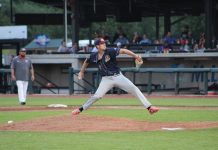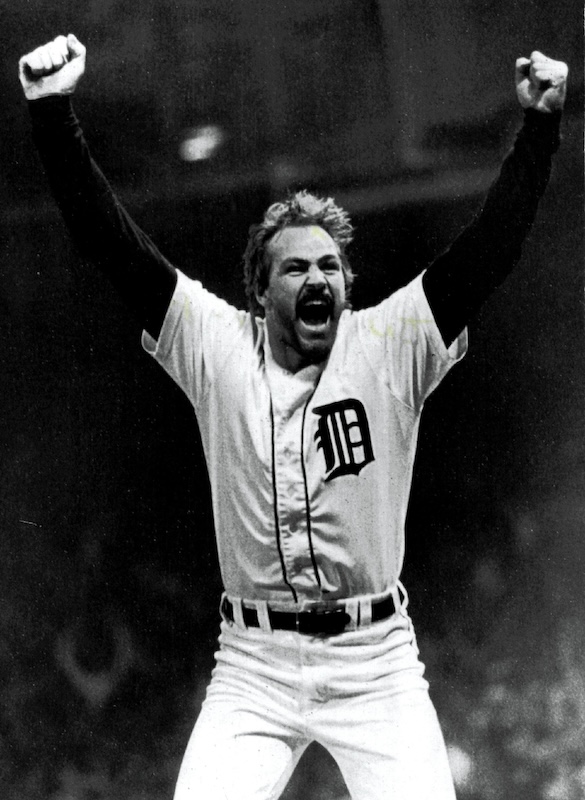
Current Detroit Tigers manager A.J. Hinch was 10 years old. No current Tigers player was born yet. And you would have to be at least 45 years old to remember the remarkable 1984 season during which Detroit’s beloved baseball team captured its last world championship 40 years ago at Tiger Stadium.
Yet those fortunate enough to have witnessed what happened that year will cherish the memories forever.
In a city and state suffering from a crippled automobile-dominated economy, the Tigers, led by manager Sparky Anderson, gave Detroit fans something to cheer about during a championship season also remembered for a ‚ÄúBless you boys‚ÄĚ slogan, the wave, enthusiastic ‚Äúbleacher creatures,‚ÄĚ groundskeeper Herbie Redmond dancing in the fifth inning to John Denver‚Äôs
‚ÄúThank God I‚Äôm a Country Boy,‚ÄĚ and new owner and pizza magnate Tom Monaghan arriving by helicopter and landing on top of the Checker Cab building across from the ballpark.
It was also the first year that Joe Diroff, known as ‚ÄúThe Brow‚ÄĚ because of his bushy eyebrows, became the team‚Äôs unofficial cheerleader as he held up condiment bottles yelling that the opponent ‚Äúcan‚Äôt catch up because they can‚Äôt cut the mustard.‚ÄĚ
‚ÄúIn 1983, we knew we were good enough to win a championship, but we finished second and couldn‚Äôt overtake Baltimore [the eventual world champions], though we had a better record against them. That gave everybody fire in the belly knowing ‚Äô84 could be our year,‚ÄĚ says former Tigers catcher Lance Parrish, who with former Detroit News Tigers beat writer Tom Gage penned the recently released book (Triumph Books).
Parrish and middle infielders Alan Trammell and Lou Whitaker, pitchers Jack Morris and Dan Petry, and outfielder Kirk Gibson formed a nucleus of talent in their prime that had been groomed together in the Tigers’ farm system thanks to the savvy drafting by Tigers general manager Bill Lajoie.
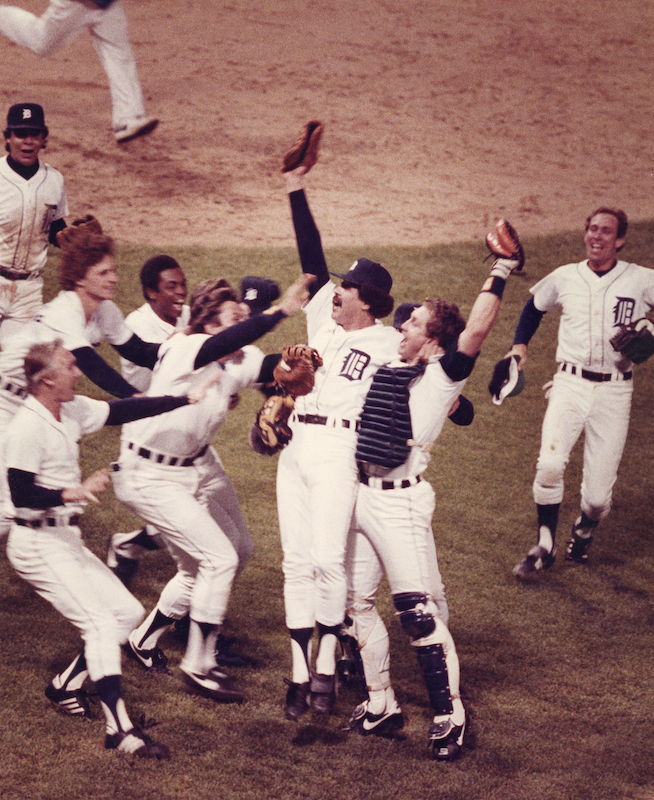
With Lajoie’s preseason signing of free agent veteran slugger Darrell Evans and the acquisitions of reliever Willie Hernández and utility first baseman Dave Bergman, the Tigers had sharpened their teeth and were poised for success.
Yet, no one could have imagined their incredible start, which quickly drew national attention and record crowds at Tiger Stadium.
The Tigers won their first nine games, including a no-hitter by Morris in Chicago, while pulling off 17 consecutive road victories on their way to an astonishing 35-5 start, still a major league record for the first 40 games of a season.
‚ÄúI‚Äôll never forget that when the Tigers returned home for a series against Baltimore after going 35-8, WDIV telecasts had incredible ratings [then] and throughout the year because everyone was watching the Tigers,‚ÄĚ says Eli Zaret, who hosted a must-see 30-minute pregame show on the NBC affiliate before each telecast by George Kell and Al Kaline. That same year, the Pro Am Sports System (better known as PASS Sports), in its inaugural season as one of the first pay-per-view regional sports television networks, carried 80 games, while radio listeners tuned in to Ernie Harwell and Paul Carey on WJR.
But nothing compared to being at the ballpark that season, where the average attendance per game was 33,393, while a total of 2,704,794 fans set what was then a franchise attendance record.
‚ÄúTiger Stadium was a magical place to play, a baseball cathedral where, with the double-decked stands all around, the fans were right on top of you,‚ÄĚ Parrish says. ‚ÄúYou could really feel the electricity, and with the fans doing the wave all the time, it was very motivating.‚ÄĚ
The wave, the practice of fans standing and raising their arms and cheering section by section, had first appeared locally during football games at the University of Michigan the previous fall, but in 1984, it was perfected and popularized at Tiger Stadium while drawing national attention. Fans started the infectious wave spontaneously in the lower- or upper-deck stands, and it circled the packed stadium, sometimes in either slow or fast motion.
‚ÄúTiger Stadium was rocking that year, and when the fans were stomping their feet, it felt like it was going to fall down,‚ÄĚ says Trammell, now a special assistant in the Tigers‚Äô front office. ‚ÄúThe crowds were so loud, and with the wave, it had a huge impact on us and it felt like we had a real home-field advantage. It just puts a smile on my face thinking about that time because it was an unbelievable dream year.‚ÄĚ
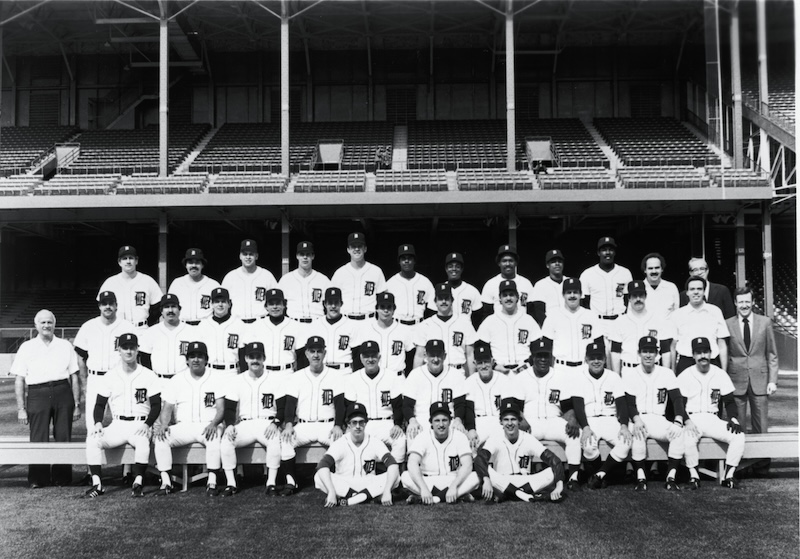
During his nearly 40-year staff and freelance writing career with the Detroit Free Press, Bill McGraw agreed to work just one year as the full-time Tigers beat writer, and as he says, ‚ÄúLucky for me,‚ÄĚ that year was 1984.
‚ÄúSitting in the press box on the third deck behind home plate that season, I saw the greatest show you could ever want to see, especially at night with the window open,‚ÄĚ McGraw says. ‚ÄúBesides watching great baseball, you would see the wave, hear the chants from each end of the center field bleachers ‚ÄĒ ‚ÄėTastes great, less filling‚Äô ‚ÄĒ and watch beach balls being bounced around up there in the center field bleachers. It was like a championship-type buzz almost every game.‚ÄĚ
After finishing the regular season 15 games ahead of second-place Toronto with a 104-58 record, still the most wins in franchise history, Detroit swept the Kansas City Royals in the American League Championship Series to capture the American League title before facing the San Diego Padres in the World Series.
The Tigers split the first two games in San Diego and took a 2-1 series lead after winning Game 3 in Detroit 5-2. The next day, Trammell was the hero, giving Morris his second Fall Classic win after blasting two two-run homers in a 4-2 victory.
David Cowart (in the team photo above, front and center) was the lucky Tigers batboy that day.
‚ÄúThat whole year was awesome, and the coolest part was when I could congratulate a Tiger at home plate after a home run because you had a chance to be on the news or even appear on This Week in Baseball,‚ÄĚ says Cowart, 61, a retired Ford Motor Co. electrical engineer. ‚ÄúWhen Alan hit his second home run, a picture of me carrying his bat and running into the dugout behind him appeared the next day on the front of The Detroit News, and I have it framed and hanging on my wall at home.‚ÄĚ
Now leading the Series three games to one, the Tigers were determined to become champions the following day in front of their fans and avoid returning to San Diego to finish the Series.
It had been 16 years since the Tigers won the 1968 World Series in St. Louis and 49 years since they’d captured a world championship at home: In 1935, they beat the Chicago Cubs at Navin Field.

Before Game 5 started at 4:45 p.m. on Sunday, Oct. 14, the Detroit Free Press Marathon finished, the Lions defeated the Tampa Bay Buccaneers in overtime at the Silverdome, and Ford reached a tentative settlement with the United Auto Workers.
Among the fortunate fans attending the game were author Elmore Leonard; Chicago Seven activist and Royal Oak native Tom Hayden; Ford CEO and Chairman Philip Caldwell; former UAW President Doug Fraser; 1968 World Series MVP Mickey Lolich and his wife, Joyce (who were unceremoniously given seats by the Tigers in the second-to-last row of the upper deck down the third baseline); Vice President George H.W. Bush seated next to George Kell, who threw the ceremonial first pitch from his seat; and yours truly sitting in a lower-deck right field seat.
Meanwhile, hundreds of others without tickets congregated outside of the stadium and nearby bars as millions across the country tuned in to the NBC telecast by Vin Scully and Joe Garagiola.
‚ÄúI remember it was a weird day weatherwise because it was very foggy; that gave an otherworldly feel to it,‚ÄĚ McGraw says. ‚ÄúAll around, there was this buzz and positive energy in anticipation that we were going to witness a championship that night.‚ÄĚ
The Tigers took a 3-0 lead in the first inning thanks largely to Gibson’s two-run homer, but by the seventh inning, Detroit was holding onto a slim 4-3 lead.
With one out for San Diego, as imposing Padres reliever Rich ‚ÄúGoose‚ÄĚ Gossage walked in from the bullpen to replace Craig Lefferts and face Parrish, the Ghostbusters theme song played on the loudspeakers while the fans yelled, ‚ÄúGoosebusters!‚ÄĚ after the refrain ‚ÄúWho you gonna call?‚ÄĚ
‚ÄúI was laughing inside because the whole stadium was yelling it, but I was trying to stay focused and I was pumped,‚ÄĚ Parrish says. On an 0-1 count, he smashed a line drive rocket over the left field fence as the crowd went crazy, with Detroit taking a 5-3 lead. ‚ÄúIt was a huge thrill to hit that homer under those circumstances and for what it meant to the team.‚ÄĚ
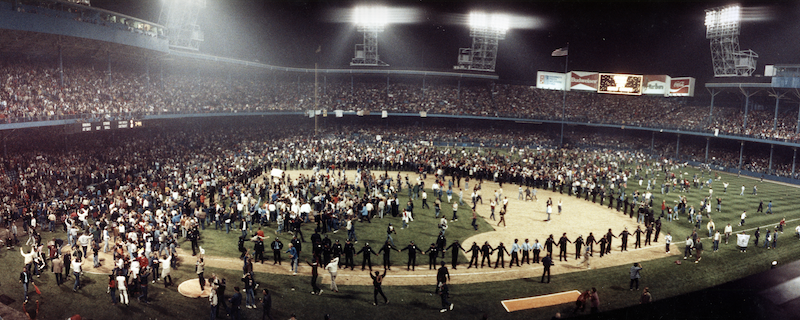
Yet the World Series’ most dramatic and signature blow took place in the eighth inning after the Padres’ Kurt Bevacqua hit a solo homer off Hernández to make it a narrow 5-4 Detroit lead.
In the bottom of the eighth, with runners on second and third, first base open, and one out with Gibson at the plate, conventional baseball wisdom called for an intentional walk to set up a double play or at least a force-out at the plate, and that’s what San Diego manager Dick Williams had called for. During a confab on the mound, Gossage convinced Williams that he should pitch to Gibson.
In a 2009 interview with Gibson by this writer, he explained what happened next.
‚ÄúGossage had owned me, and he struck me out in my first major league at bat. I knew he thought he could strike me out again. I couldn‚Äôt stand there in the box when they were talking and think, ‚ÄėHe‚Äôs going to strike me out.‚Äô I had to reverse that thought, so I visualized the ball going into the upper deck.‚ÄĚ
On Gossage’s second delivery, Gibson sent a fastball into the right field upper deck, just as he’d pictured it.
The three-run blast gave the Tigers a commanding 8-4 lead as the roar from Tiger Stadium could be heard for blocks.
After Gibson crossed home plate and violently high-fived teammates and batboy Dominic Nieto, Schroeder snapped the photo of the helmetless Tiger with ripped pants, fists clenched, and arms raised looking like a wild man as he yelled with joy in front of the dugout to the thunderous crowd. The next day, the photo ran nearly the entire length of the front page of the Free Press, and it quickly became a popular keepsake poster.
And then at 7:41 p.m., San Diego’s Tony Gwynn hit a shallow fly ball toward left fielder Larry Herndon, who raced in to catch the final out to secure the Tigers’ fourth world championship as the fans let out a tremendous roar.

All hell broke loose as the Tigers players ran from their positions and out of the dugout to celebrate with Hern√°ndez on the mound while hundreds of fans jumped onto the field, with many running through a strong police force that surrounded the infield. Fans quickly began tearing out pieces of sod as souvenirs.
By winning the franchise’s fourth world championship, the 1984 Tigers joined the 1927 New York Yankees and the 1955 Brooklyn Dodgers to become only the third team to occupy first place the entire season and win a World Series. (The 1990 Cincinnati Reds and 2005 Chicago White Sox would later do it as well.) Sparky Anderson became the first manager to win world championships in both leagues.
But as the Tigers celebrated inside the Champagne-soaked locker room, a riot by rowdy fans outside the ballpark made national news, highlighted by an Associated Press photo of 17-year-old Kenneth ‚ÄúBubba‚ÄĚ Helms standing with his raised Tigers pennant in front of an overturned police car on fire. In the end, dozens were injured, 34 were arrested, and a man was fatally shot outside of Lafayette Coney Island in a robbery attempt at 11:55 p.m.
Two days later, on live television, thousands lining the streets and in office buildings watched and cheered a parade of 28 convertibles carrying the team from Tiger Stadium to Kennedy Square for a confetti-strewn rally featuring CKLW radio personality Dick Purtan as master of ceremonies. He introduced the players before short remarks were made by Mayor Coleman Young, Gov. James Blanchard, City Council President Erma Henderson, owner Tom Monaghan, Anderson, Gibson, and Trammell.
Trammell was named the Series MVP and received a Pontiac Trans Am from Sport magazine after batting .450 with two homers, six runs batted in, and five runs scored.
Later, Anderson was named the American League Manager of the Year, and Hernández received the Amercian League’s Cy Young and MVP awards.
This Aug. 31, the Tigers will honor members of the 1984 world championship team in a ceremony at Comerica Park that will provide fans the opportunity to recall that magical baseball season so long ago.
‚ÄúIt‚Äôs sad that we have lost a few of our teammates, but that‚Äôs how life works,‚ÄĚ Trammell says. ‚ÄúI‚Äôm looking forward to getting together because it‚Äôs always special to reunite and share the war stories that never get old.‚ÄĚ
Bless you boys.
This story originally appeared in the July 2024 issue of ¬ť∂Ļ∑¨ļŇ Detroit magazine. To read more, pick up a copy of ¬ť∂Ļ∑¨ļŇ Detroit at a local retail outlet. Our digital edition will be available on July 8.
|
| Őż |
|



